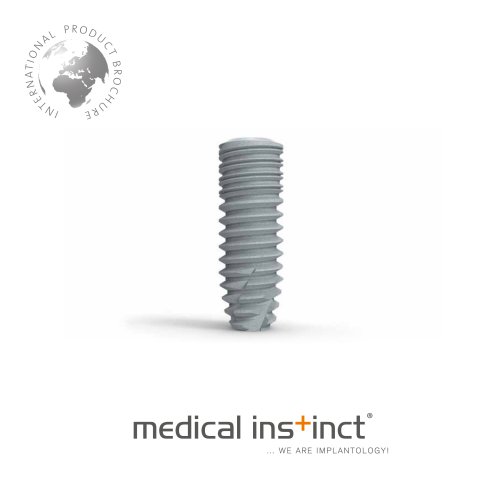
Catalog excerpts
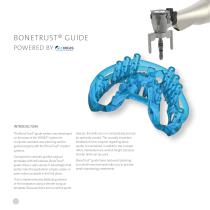
BONETRUST® GUIDEPOWERED BY INTRODUCTION The BoneTrust® guide system was developed on the basis of the 2INGIS® system for computer-assisted case planning and for guided surgery with the BoneTrust® implant systems. Compared to centrally guided surgical templates with drill sleeves, BoneTrust® guide offers a wide variety of advantages that partly make the application simpler, easier or even make it possible in the first place. This is implemented by bilateral guidance of the handpiece using a slender surgical template. Because there are no central guide sleeves, the drills can run...
Open the catalog to page 2
ADVANTAGES OF THE BONETRUST® GUIDE SYSTEM BoneTrust® guide represents the quintessence of more than 30 years of experience in implantology with regard to practicability, safety and efficiency. + STERILITY The surgical templates are available in metal or plastic variants and can be sterilized at 135°C. + VISIBILITY Thanks to the slender shape and the bilateral handpiece guidance, the surgical field is accessible without obstruction and is fully visible, + ACCESSIBILITY The special template design and the lack of drill sleeves make it very easy to insert bone replacement material...
Open the catalog to page 3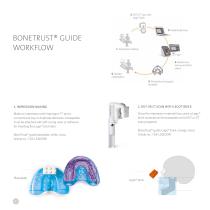
2. DVT/CT scan with Lego® brick BONETRUST® GUIDE WORKFLOW 4. Model scan, wax-up and final check 6. Guided implantation 5. Production of surgical template 2. DVT OR CT SCAN WITH LEGO® BRICK Make an impression with ImpregumTM* and a conventional tray or duplicate dentures. A baseplate must be attached with self-curing resin or adhesive for inserting the Lego® brick later. Once the impression material has cured, a Lego® brick is placed on the baseplate and a DVT or CT scan prepared. BoneTrust guide baseplate, white, 4 pcs Article no.: 193-LEGOWE ® BoneTrust® guide Lego® brick, orange, 4 pcs...
Open the catalog to page 4
3. IMPLANT PLANNING We recommend the 2INGIS® planning software for implant planning. Software solutions such as smop, coDiagnostiXTM** etc. can also be used. Integrated CT scan with Lego® brick as reference Implant planning 4. MODEL SCAN, WAX-UP AND FINAL CHECK Model scan After the model is created a wax-up of the planned prosthetic restoration is made based on the implant planning. After the model and wax-up scan, the laboratory can match all digital data and check whether surgical guide production is feasible or whether the planning needs to be amended. Final check * ImpregumTM is a...
Open the catalog to page 5
Different spacer heights are used in accordance with the surgery protocol to match the length of each implant. 5. PRODUCTION OF SURGICAL TEMPLATE AND SPACER The surgical templates can be produced in metal or plastic variants using a DLP printer. They are then delivered to the practice and could be sterilized at 135° C. Plastic surgical template Various spacers 6. IMPLANTATION IN ACCORDANCE WITH BONETRUST® GUIDE PROTOCOL Each surgical template is supplied with an individual drill protocol. This shows all individual steps up to implant insertion. Bone level Legs Long Legs Short BONETRUST®...
Open the catalog to page 6
BONETRUST® GUIDE DRILL SYSTEM BONE THREADER TWIST DRILL CRESTAL DRILL TWIST DRILL, SHORT FLAT DRILL GINGIVA PUNCH Only drills and instruments with the plus symbol (+) may be used for the BoneTrust® guide system. For the BoneTrust® guide system one of the following W&H handpieces is required: WI-75 E/KM without light, cannot be dismantled WS-75 without light, can be dismantled WS-75L with light (via contact with motor), can be dismantled WS-75LG with light, can be dismantled (also suitable for machines without light)
Open the catalog to page 7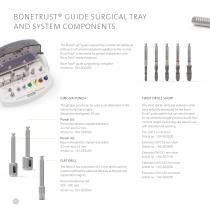
BONETRUST® GUIDE SURGICAL TRAY AND SYSTEM COMPONENTS The BoneTrust® guide surgical tray contains all additional drills and instruments required in addition to the normal BoneTrust® instruments for guided implantation with BoneTrust® implant systems. BoneTrust® guide surgical tray, complete Article no.: 190-300393 GINGIVA PUNCH The gingiva punch can be used as an alternative to the conventional flap surgery. Recommended speed: 30 rpm Punch 5.0 Recommended for implant diameters 4.0 mm and 5.0 mm. Article no.: 190-254500 Punch 4.0 Recommended for implant diameters 3.0 mm and 3.4 mm. Article...
Open the catalog to page 8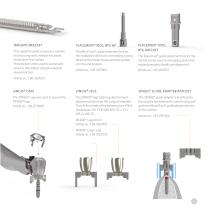
IMPLANT BRACKET The implant bracket is used as a transfer and securing aid to release the plastic mount from the implant. The bracket is then used to accept and screw in the implant using the desired placement tool. The BoneTrust® guide placement tool for the handpiece clicks onto the seating coping allowing the implant to be securely guided into the end position. PLACEMENT TOOL, BTG RATCHET The BoneTrust® guide placement tool for the ratchet can be used to manually position the implant precisely (depth and alignment). 2INGIS® GUIDE ADAPTER RATCHET The 2INGIS® caps are used to secure the...
Open the catalog to page 9
With the legs the handpiece engages into the guidance of the surgical template. The short and long legs stop at the designated stops in the drill template guides and match the drill length and the available space. The gingiva punch 4.0 mm or 5.0 mm (depending on implant diameter) can be used as an alternative to the normal opening of a mucous membrane flap. Flat Drill 3.3 mm The 2.0/2.8/3.1/3.25/4.25 mm twist drills short are used in conjunction with the corresponding legs to prepare up to the desired implant diameter. The drill depth is set by the stops on the guide sleeves and...
Open the catalog to page 10
Crestal drill 3.0/3.3 mm 3.75/4.75 mm corresponding to implant diameter. Inserting the implant using the handpiece. + Placement Tool, BTG HP The longer 2.0/2.8/3.1 mm or 3.25/4.25 mm twist drills are used in conjunction with the corresponding legs to prepare up to the desired implant diameter. The drill depth/implant length is set by the corresponding spacer. To avoid excessive insertion torques, the 3.0/3.4/4.0 mm or 5.0 mm bone threader (depending on implant diameter) should be used with very cortical bone structures and principally in the maxilla at max. 30 rpm. Inserting the implant...
Open the catalog to page 11All Medical Instinct Deutschland catalogs and technical brochures
-
BONE TRUST ® IMPLANT SYSTEMS
60 Pages
-
Produktkatalog
36 Pages


